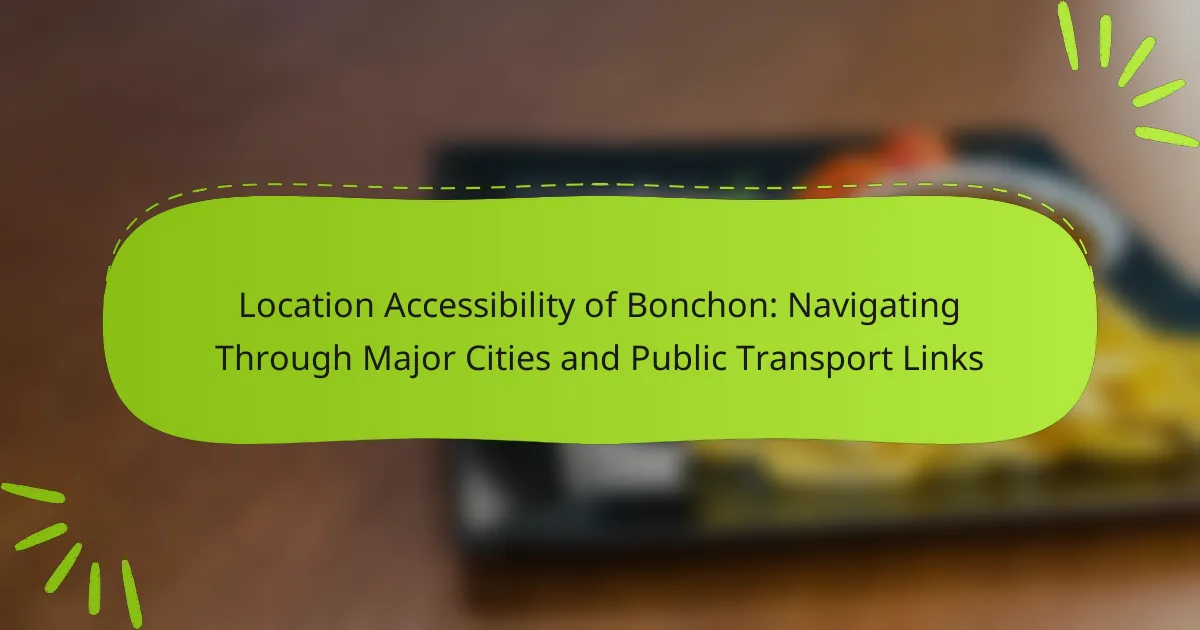Bonchon is a popular restaurant chain known for its Korean fried chicken and other menu offerings. This article examines the location accessibility of Bonchon outlets in major cities, highlighting their strategic positioning near public transportation hubs such as bus stops and subway stations. It discusses the advantages of high foot traffic in urban areas, available parking options, and the presence of accessibility features for individuals with disabilities. The overall aim of Bonchon is to ensure convenient access for all customers, enhancing their dining experience in easily reachable locations.

What is the Location Accessibility of Bonchon?
Bonchon locations are generally accessible in major cities. Many outlets are situated near public transportation hubs. This includes proximity to bus stops and subway stations. In urban areas, Bonchon often benefits from high foot traffic. Most locations provide parking options for customers. Accessibility features are typically available for individuals with disabilities. Overall, Bonchon aims to be conveniently located for easy access.
How does Bonchon ensure accessibility in major cities?
Bonchon ensures accessibility in major cities by strategically placing its locations near public transport hubs. This allows customers to easily reach the restaurants via buses and trains. Additionally, Bonchon designs its restaurant layouts to accommodate all customers, including those with disabilities. The brand also provides clear signage and directions to enhance navigation. In major cities, Bonchon frequently conducts assessments to identify areas for improvement in accessibility. They prioritize locations that are pedestrian-friendly and have ample parking facilities. These efforts reflect Bonchon’s commitment to making its dining experience accessible to everyone.
What are the key locations of Bonchon restaurants in urban areas?
Bonchon restaurants are key locations in major urban areas including New York City, Los Angeles, and Chicago. These cities host multiple Bonchon outlets, making them easily accessible. In New York City, Bonchon has locations in neighborhoods like Koreatown and the Upper West Side. Los Angeles features Bonchon restaurants in Koreatown and downtown areas. Chicago’s Bonchon locations are primarily found in the suburbs and the city center. These urban placements cater to high foot traffic and diverse populations.
How does Bonchon’s location strategy cater to diverse populations?
Bonchon’s location strategy caters to diverse populations by selecting sites in urban areas with high foot traffic. This includes locations near shopping centers, universities, and public transportation hubs. These areas attract a mix of customers from various demographics. The brand aims to create accessibility for families, students, and professionals alike. By being present in multicultural neighborhoods, Bonchon appeals to a broad audience. This strategy enhances visibility and convenience for diverse consumer groups. The choice of locations aligns with Bonchon’s goal to reach a wide customer base effectively.
Why is public transport important for accessing Bonchon?
Public transport is important for accessing Bonchon because it provides convenient and affordable means of travel. Many Bonchon locations are situated in urban areas with high traffic congestion. Public transport alleviates the stress of driving and parking. It allows customers to easily reach Bonchon without incurring high transportation costs. Furthermore, public transport networks often connect various neighborhoods, making Bonchon accessible to a broader audience. Studies show that areas served by public transport experience increased foot traffic, benefiting businesses like Bonchon. Therefore, efficient public transport is essential for enhancing accessibility to Bonchon locations.
What public transport options are available near Bonchon locations?
Public transport options near Bonchon locations typically include buses, subways, and light rail services. Many Bonchon outlets are situated in urban areas with extensive public transportation networks. For instance, major cities often have bus routes that stop near Bonchon restaurants. Subway stations may also be within walking distance, providing easy access. Light rail systems can connect to Bonchon locations in cities where they operate. Specific transport options vary by city, so checking local transit maps is advisable. Public transport schedules and routes can also be found on city transit websites for precise planning.
How do transport links enhance the customer experience at Bonchon?
Transport links enhance the customer experience at Bonchon by providing convenient access to the restaurant. Efficient public transportation options, such as buses and subways, allow customers to reach Bonchon easily. This accessibility attracts more foot traffic, increasing customer visits. Proximity to major transport hubs also reduces travel time for patrons. Additionally, clear signage and directions improve navigability for first-time visitors. The ease of access encourages repeat business from satisfied customers. Overall, strong transport links contribute to a positive dining experience at Bonchon.
What challenges exist regarding Bonchon’s location accessibility?
Bonchon faces several challenges regarding location accessibility. Many of its outlets are situated in busy urban areas. These locations often have limited parking availability. Public transport options may not be conveniently located near some restaurants. High foot traffic can make access difficult during peak hours. Additionally, some locations may not comply with accessibility standards for individuals with disabilities. These factors can hinder overall customer access to Bonchon outlets.
What factors contribute to accessibility issues in certain areas?
Accessibility issues in certain areas are influenced by multiple factors. Geographic layout significantly impacts access to services. Urban design can create barriers for individuals with mobility challenges. Public transportation availability and efficiency affect how easily people can reach destinations. Socioeconomic status also plays a role; lower-income areas may have fewer resources for infrastructure improvements. Local policies and regulations can hinder accessibility initiatives. Environmental factors, such as weather conditions, can temporarily affect accessibility as well. Finally, community awareness and advocacy influence the prioritization of accessibility improvements.
How does Bonchon address accessibility challenges?
Bonchon addresses accessibility challenges by ensuring its locations are compliant with the Americans with Disabilities Act (ADA). Each restaurant is designed with features such as wheelchair ramps and accessible restrooms. Bonchon also provides clear signage to guide customers with disabilities. Additionally, staff are trained to assist guests with mobility issues. The restaurant layout is designed to allow easy movement for all patrons. Bonchon aims to create an inclusive dining experience for everyone. These measures demonstrate Bonchon’s commitment to accessibility in its locations.
How can customers navigate to Bonchon using public transport?
Customers can navigate to Bonchon using public transport by taking the subway or bus routes that service the area. For subway access, customers should identify the nearest subway station to their location. They can then take the appropriate line to reach the station closest to Bonchon. Bus routes are also available, and customers can check local transit websites for specific bus numbers that stop near Bonchon. Additionally, using transit apps can provide real-time directions and updates on service schedules. These methods ensure efficient travel to Bonchon in various cities.
What are the best practices for reaching Bonchon locations efficiently?
Use navigation apps to find the quickest routes to Bonchon locations. These apps provide real-time traffic updates and alternative routes. Public transportation is a reliable option for reaching Bonchon. Check local transit schedules for buses and trains that stop near Bonchon. If driving, consider peak hours to avoid heavy traffic. Parking availability varies by location; check Bonchon’s website for details. Plan your visit during off-peak hours for a smoother experience. Always verify the location address before heading out to ensure accuracy.
What tips can help customers plan their visit to Bonchon?
To plan a visit to Bonchon, customers should consider checking the location’s hours of operation. Bonchon typically operates during lunch and dinner hours, which can vary by location. Customers should also look for nearby public transport options. Many Bonchon locations are accessible via buses and trains, making travel easier. It is advisable to review the menu online before visiting. This helps customers decide on their order in advance. Additionally, making a reservation can reduce wait times during peak hours. Customers should also check for any ongoing promotions or special events. This information can enhance their dining experience. Finally, considering parking availability is important for those driving to the location.
How can customers utilize mobile apps for navigating to Bonchon?
Customers can utilize mobile apps for navigating to Bonchon by using GPS navigation features. These apps provide real-time directions to the nearest Bonchon location. Users can enter their current location and select Bonchon as the destination. The apps will display the fastest route available. They often include options for driving, walking, or public transport. Many navigation apps also offer traffic updates and estimated arrival times. Popular apps like Google Maps or Waze are commonly used for this purpose. These apps ensure customers reach Bonchon efficiently and conveniently.
Bonchon is a restaurant chain known for its accessibility in major urban areas. The article examines Bonchon’s strategic location choices near public transportation hubs, enhancing customer access through convenient transport links. It highlights key urban locations, the importance of public transport, and how Bonchon addresses accessibility challenges, including compliance with disability standards. Additionally, best practices for navigating to Bonchon using public transport and tips for planning visits are provided, ensuring a comprehensive understanding of the brand’s commitment to accessibility.
